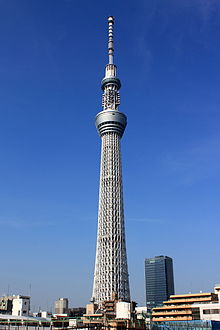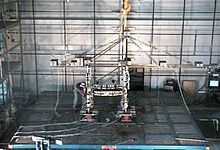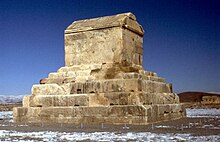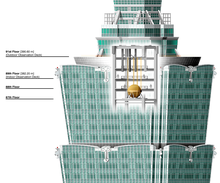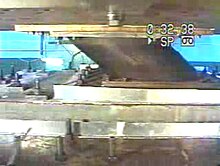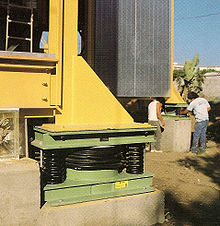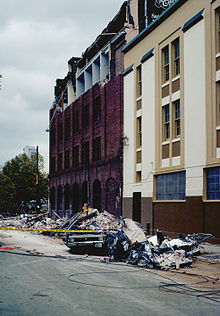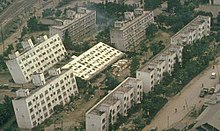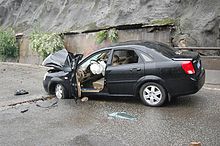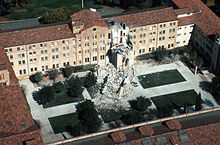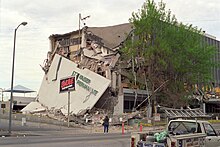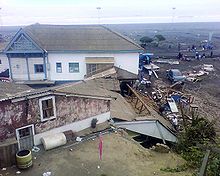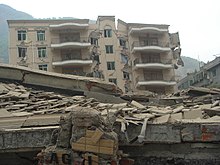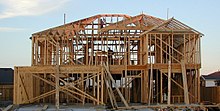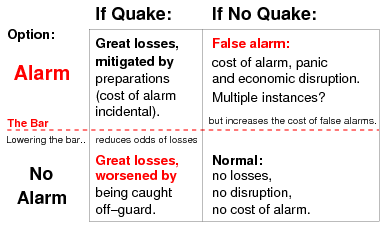Earthquake engineering is an interdisciplinary branch of engineering that designs and analyzes structures, such as buildings and bridges, with earthquakes
in mind. Its overall goal is to make such structures more resistant to
earthquakes. An earthquake (or seismic) engineer aims to construct
structures that will not be damaged in minor shaking and will avoid
serious damage or collapse in a major earthquake. Earthquake engineering
is the scientific field concerned with protecting society, the natural
environment, and the man-made environment from earthquakes by limiting
the seismic risk to socio-economically acceptable levels. Traditionally, it has been narrowly defined as the study of the behavior of structures and geo-structures subject to seismic loading; it is considered as a subset of structural engineering, geotechnical engineering, mechanical engineering, chemical engineering, applied physics,
etc. However, the tremendous costs experienced in recent earthquakes
have led to an expansion of its scope to encompass disciplines from the
wider field of civil engineering, mechanical engineering, nuclear engineering, and from the social sciences, especially sociology, political science, economics, and finance.
The main objectives of earthquake engineering are:
- Foresee the potential consequences of strong earthquakes on urban areas and civil infrastructure.
- Design, construct and maintain structures to perform at earthquake exposure up to the expectations and in compliance with building codes.
Shake-table crash testing of a regular building model (left) and a base-isolated building model (right) at UCSD
Seismic loading
Tokyo Skytree, equipped with a tuned mass damper, is the world's tallest tower and is the world's second tallest structure.
Seismic loading means application of an earthquake-generated
excitation on a structure (or geo-structure). It happens at contact
surfaces of a structure either with the ground, with adjacent structures, or with gravity waves from tsunami. The loading that is expected at a given location on the Earth's surface is estimated by engineering seismology. It is related to the seismic hazard of the location.
Seismic performance
Earthquake or seismic performance defines a structure's ability to sustain its main functions, such as its safety and serviceability, at and after a particular earthquake exposure. A structure is normally considered safe if it does not endanger the lives and well-being of those in or around it by partially or completely collapsing. A structure may be considered serviceable if it is able to fulfill its operational functions for which it was designed.
Basic concepts of the earthquake engineering, implemented in the
major building codes, assume that a building should survive a rare, very
severe earthquake by sustaining significant damage but without globally
collapsing. On the other hand, it should remain operational for more frequent, but less severe seismic events.
Seismic performance assessment
Engineers
need to know the quantified level of the actual or anticipated seismic
performance associated with the direct damage to an individual building
subject to a specified ground shaking.
Such an assessment may be performed either experimentally or
analytically.
Experimental assessment
Experimental evaluations are expensive tests that are typically done by placing a (scaled) model of the structure on a shake-table that simulates the earth shaking and observing its behavior. Such kinds of experiments were first performed more than a century ago. Only recently has it become possible to perform 1:1 scale testing on full structures.
Due to the costly nature of such tests, they tend to be used
mainly for understanding the seismic behavior of structures, validating
models and verifying analysis methods. Thus, once properly validated,
computational models and numerical procedures tend to carry the major
burden for the seismic performance assessment of structures.
Analytical/Numerical assessment
Snapshot from shake-table video of a 6-story non-ductile concrete building destructive testing
Seismic performance assessment or seismic structural analysis
is a powerful tool of earthquake engineering which utilizes detailed
modelling of the structure together with methods of structural analysis
to gain a better understanding of seismic performance of building and non-building structures. The technique as a formal concept is a relatively recent development.
In general, seismic structural analysis is based on the methods of structural dynamics. For decades, the most prominent instrument of seismic analysis has been the earthquake response spectrum method which also contributed to the proposed building code's concept of today.
However, such methods are good only for linear elastic systems,
being largely unable to model the structural behavior when damage (i.e.,
non-linearity) appears. Numerical step-by-step integration proved to be a more effective method of analysis for multi-degree-of-freedom structural systems with significant non-linearity under a transient process of ground motion excitation. Use of the finite element method is one of the most common approaches for analyzing non-linear soil structure interaction computer models.
Basically, numerical analysis is conducted in order to evaluate
the seismic performance of buildings. Performance evaluations are
generally carried out by using nonlinear static pushover analysis or
nonlinear time-history analysis. In such analyses, it is essential to
achieve accurate non-linear modeling of structural components such as
beams, columns, beam-column joints, shear walls etc. Thus, experimental
results play an important role in determining the modeling parameters of
individual components, especially those that are subject to significant
non-linear deformations. The individual components are then assembled
to create a full non-linear model of the structure. Thus created models
are analyzed to evaluate the performance of buildings.
The capabilities of the structural analysis software are a major
consideration in the above process as they restrict the possible
component models, the analysis methods available and, most importantly,
the numerical robustness. The latter becomes a major consideration for
structures that venture into the non-linear range and approach global or
local collapse as the numerical solution becomes increasingly unstable
and thus difficult to reach. There are several commercially available
Finite Element Analysis software's such as CSI-SAP2000 and
CSI-PERFORM-3D, MTR/SASSI, Scia Engineer-ECtools, ABAQUS, and Ansys,
all of which can be used for the seismic performance evaluation of
buildings. Moreover, there is research-based finite element analysis
platforms such as OpenSees, MASTODON, which is based on the MOOSE Framework, RUAUMOKO and the older DRAIN-2D/3D, several of which are now open source.
Research for earthquake engineering
Shake-table testing of Friction Pendulum Bearings at EERC
Research for earthquake engineering means both field and analytical
investigation or experimentation intended for discovery and scientific
explanation of earthquake engineering related facts, revision of
conventional concepts in the light of new findings, and practical
application of the developed theories.
The National Science Foundation
(NSF) is the main United States government agency that supports
fundamental research and education in all fields of earthquake
engineering. In particular, it focuses on experimental, analytical and
computational research on design and performance enhancement of
structural systems.
E-Defense Shake Table
The Earthquake Engineering Research Institute (EERI) is a leader in dissemination of earthquake engineering research related information both in the U.S. and globally.
A definitive list of earthquake engineering research related shaking tables around the world may be found in Experimental Facilities for Earthquake Engineering Simulation Worldwide. The most prominent of them is now E-Defense Shake Table in Japan.
Major U.S. research programs
Large High Performance Outdoor Shake Table, UCSD, NEES network
NSF also supports the George E. Brown, Jr. Network for Earthquake Engineering Simulation
The NSF Hazard Mitigation and Structural Engineering program
(HMSE) supports research on new technologies for improving the behavior
and response of structural systems subject to earthquake hazards;
fundamental research on safety and reliability of constructed systems;
innovative developments in analysis
and model based simulation of structural behavior and response
including soil-structure interaction; design concepts that improve structure performance and flexibility; and application of new control techniques for structural systems.
(NEES) that advances knowledge discovery and innovation for earthquakes and tsunami loss reduction of the nation's civil infrastructure and new experimental simulation techniques and instrumentation.
The NEES network features 14 geographically-distributed,
shared-use laboratories that support several types of experimental work: geotechnical centrifuge research, shake-table tests, large-scale structural testing, tsunami wave basin experiments, and field site research. Participating universities include: Cornell University; Lehigh University; Oregon State University; Rensselaer Polytechnic Institute; University at Buffalo, State University of New York; University of California, Berkeley; University of California, Davis; University of California, Los Angeles; University of California, San Diego; University of California, Santa Barbara; University of Illinois, Urbana-Champaign; University of Minnesota; University of Nevada, Reno; and the University of Texas, Austin.
NEES at Buffalo testing facility
The equipment sites (labs) and a central data repository are
connected to the global earthquake engineering community via the NEEShub
website. The NEES website is powered by HUBzero software developed at Purdue University for nanoHUB specifically to help the scientific community share resources and collaborate. The cyberinfrastructure, connected via Internet2,
provides interactive simulation tools, a simulation tool development
area, a curated central data repository, animated presentations, user
support, telepresence, mechanism for uploading and sharing resources,
and statistics about users and usage patterns.
This cyberinfrastructure allows researchers to: securely store,
organize and share data within a standardized framework in a central
location; remotely observe and participate in experiments through the
use of synchronized real-time data and video; collaborate with
colleagues to facilitate the planning, performance, analysis, and
publication of research experiments; and conduct computational and
hybrid simulations that may combine the results of multiple distributed
experiments and link physical experiments with computer simulations to
enable the investigation of overall system performance.
These resources jointly provide the means for collaboration and
discovery to improve the seismic design and performance of civil and
mechanical infrastructure systems.
Earthquake simulation
The very first earthquake simulations were performed by statically applying some horizontal inertia forces based on scaled peak ground accelerations to a mathematical model of a building. With the further development of computational technologies, static approaches began to give way to dynamic ones.
Dynamic experiments on building and non-building structures may be physical, like shake-table testing,
or virtual ones. In both cases, to verify a structure's expected
seismic performance, some researchers prefer to deal with so called
"real time-histories" though the last cannot be "real" for a
hypothetical earthquake specified by either a building code or by some
particular research requirements. Therefore, there is a strong incentive
to engage an earthquake simulation which is the seismic input that
possesses only essential features of a real event.
Sometimes earthquake simulation is understood as a re-creation of local effects of a strong earth shaking.
Structure simulation
Concurrent experiments with two building models which are kinematically equivalent to a real prototype.
Theoretical or experimental evaluation of anticipated seismic performance mostly requires a structure simulation which is based on the concept of structural likeness or similarity. Similarity is some degree of analogy or resemblance between two or more objects. The notion of similarity rests either on exact or approximate repetitions of patterns in the compared items.
In general, a building model is said to have similarity with the real object if the two share geometric similarity, kinematic similarity and dynamic similarity. The most vivid and effective type of similarity is the kinematic one. Kinematic similarity exists when the paths and velocities of moving particles of a model and its prototype are similar.
The ultimate level of kinematic similarity is kinematic equivalence
when, in the case of earthquake engineering, time-histories of each
story lateral displacements of the model and its prototype would be the
same.
Seismic vibration control
Seismic vibration control is a set of technical means aimed to mitigate seismic impacts in building and non-building structures. All seismic vibration control devices may be classified as passive, active or hybrid where:
- passive control devices have no feedback capability between them, structural elements and the ground;
- active control devices incorporate real-time recording instrumentation on the ground integrated with earthquake input processing equipment and actuators within the structure;
- hybrid control devices have combined features of active and passive control systems.
When ground seismic waves
reach up and start to penetrate a base of a building, their energy flow
density, due to reflections, reduces dramatically: usually, up to 90%.
However, the remaining portions of the incident waves during a major
earthquake still bear a huge devastating potential.
After the seismic waves enter a superstructure,
there are a number of ways to control them in order to soothe their
damaging effect and improve the building's seismic performance, for
instance:
- to dissipate the wave energy inside a superstructure with properly engineered dampers;
- to disperse the wave energy between a wider range of frequencies;
- to absorb the resonant portions of the whole wave frequencies band with the help of so-called mass dampers.
Mausoleum of Cyrus, the oldest base-isolated structure in the world
Devices of the last kind, abbreviated correspondingly as TMD for the tuned (passive), as AMD for the active, and as HMD for the hybrid mass dampers, have been studied and installed in high-rise buildings, predominantly in Japan, for a quarter of a century.
However, there is quite another approach: partial suppression of the seismic energy flow into the superstructure known as seismic or base isolation.
For this, some pads are inserted into or under all major
load-carrying elements in the base of the building which should
substantially decouple a superstructure from its substructure resting on a shaking ground.
The first evidence of earthquake protection by using the principle of base isolation was discovered in Pasargadae,
a city in ancient Persia, now Iran, and dates back to the 6th century
BCE. Below, there are some samples of seismic vibration control
technologies of today.
Dry-stone walls control
Dry-stone walls of Machu Picchu Temple of the Sun, Peru
People of Inca civilization were masters of the polished 'dry-stone walls', called ashlar, where blocks of stone were cut to fit together tightly without any mortar. The Incas were among the best stonemasons the world has ever seen and many junctions in their masonry were so perfect that even blades of grass could not fit between the stones.
Peru is a highly seismic land and for centuries the mortar-free construction
proved to be apparently more earthquake-resistant than using mortar.
The stones of the dry-stone walls built by the Incas could move slightly
and resettle without the walls collapsing, a passive structural control technique employing both the principle of energy dissipation (coulomb damping) and that of suppressing resonant amplifications.
Tuned mass damper
Tuned mass damper in Taipei 101, the world's third tallest skyscraper
Typically the tuned mass dampers are huge concrete blocks mounted in skyscrapers or other structures and move in opposition to the resonance frequency oscillations of the structures by means of some sort of spring mechanism.
The Taipei 101 skyscraper needs to withstand typhoon winds and earthquake tremors common in this area of Asia/Pacific. For this purpose, a steel pendulum
weighing 660 metric tonnes that serves as a tuned mass damper was
designed and installed atop the structure. Suspended from the 92nd to
the 88th floor, the pendulum sways to decrease resonant amplifications
of lateral displacements in the building caused by earthquakes and
strong gusts.
Hysteretic dampers
A hysteretic damper
is intended to provide better and more reliable seismic performance
than that of a conventional structure by increasing the dissipation of seismic input energy. There are five major groups of hysteretic dampers used for the purpose, namely:
- Fluid viscous dampers (FVDs)
Viscous Dampers have the benefit of being a supplemental damping
system. They have an oval hysteretic loop and the damping is velocity
dependent. While some minor maintenance is potentially required, viscous
dampers generally do not need to be replaced after an earthquake. While
more expensive than other damping technologies they can be used for
both seismic and wind loads and are the most commonly used hysteretic
damper.
- Friction dampers (FDs)
Friction dampers tend to be available in two major types, linear and
rotational and dissipate energy by heat. The damper operates on the
principle of a coulomb damper. Depending on the design, friction dampers can experience stick-slip phenomenon and Cold welding.
The main disadvantage being that friction surfaces can wear over time
and for this reason they are not recommended for dissipating wind loads.
When used in seismic applications wear is not a problem and there is no
required maintenance. They have a rectangular hysteretic loop and as
long as the building is sufficiently elastic they tend to settle back to
their original positions after an earthquake.
- Metallic yielding dampers (MYDs)
Metallic yielding dampers, as the name implies, yield in order to
absorb the earthquake's energy. This type of damper absorbs a large
amount of energy however they must be replaced after an earthquake and
may prevent the building from settling back to its original position.
- Viscoelastic dampers (VEDs)
Viscoelastic dampers are useful in that they can be used for both
wind and seismic applications, they are usually limited to small
displacements. There is some concern as to the reliability of the
technology as some brands have been banned from use in buildings in the
United States.
Base isolation
Base
isolation seeks to prevent the kinetic energy of the earthquake from
being transferred into elastic energy in the building. These
technologies do so by isolating the structure from the ground, thus
enabling them to move somewhat independently. The degree to which the
energy is transferred into the structure and how the energy is
dissipated will vary depending on the technology used.
- Lead rubber bearing
LRB being tested at the UCSD Caltrans-SRMD facility
Lead rubber bearing or LRB is a type of base isolation employing a heavy damping. It was invented by Bill Robinson, a New Zealander.
Heavy damping mechanism incorporated in vibration control
technologies and, particularly, in base isolation devices, is often
considered a valuable source of suppressing vibrations thus enhancing a
building's seismic performance. However, for the rather pliant systems
such as base isolated structures, with a relatively low bearing
stiffness but with a high damping, the so-called "damping force" may
turn out the main pushing force at a strong earthquake. The video shows a Lead Rubber Bearing being tested at the UCSD
Caltrans-SRMD facility. The bearing is made of rubber with a lead core.
It was a uniaxial test in which the bearing was also under a full
structure load. Many buildings and bridges, both in New Zealand and
elsewhere, are protected with lead dampers and lead and rubber bearings.
Te Papa Tongarewa, the national museum of New Zealand, and the New Zealand Parliament Buildings have been fitted with the bearings. Both are in Wellington which sits on an active fault.
- Springs-with-damper base isolator
Springs-with-damper close-up
Springs-with-damper base isolator installed under a three-story town-house, Santa Monica, California is shown on the photo taken prior to the 1994 Northridge earthquake exposure. It is a base isolation device conceptually similar to Lead Rubber Bearing.
One of two three-story town-houses like this, which was well instrumented for recording of both vertical and horizontal accelerations on its floors and the ground, has survived a severe shaking during the Northridge earthquake and left valuable recorded information for further study.
- Simple roller bearing
Simple roller bearing is a base isolation device which is intended for protection of various building and non-building structures against potentially damaging lateral impacts of strong earthquakes.
This metallic bearing support may be adapted, with certain
precautions, as a seismic isolator to skyscrapers and buildings on soft
ground. Recently, it has been employed under the name of metallic roller bearing for a housing complex (17 stories) in Tokyo, Japan.
- Friction pendulum bearing
FPB shake-table testing
Friction pendulum bearing (FPB) is another name of friction pendulum system (FPS). It is based on three pillars:
- articulated friction slider;
- spherical concave sliding surface;
- enclosing cylinder for lateral displacement restraint.
Snapshot with the link to video clip of a shake-table testing of FPB system supporting a rigid building model is presented at the right.
Seismic design
Seismic design is based on authorized engineering procedures, principles and criteria meant to design or retrofit structures subject to earthquake exposure. Those criteria are only consistent with the contemporary state of the knowledge about earthquake engineering structures.
Therefore, a building design which exactly follows seismic code
regulations does not guarantee safety against collapse or serious
damage.
The price of poor seismic design may be enormous. Nevertheless, seismic design has always been a trial and error process whether it was based on physical laws or on empirical knowledge of the structural performance of different shapes and materials.
San Francisco City Hall destroyed by 1906 earthquake and fire.
San Francisco after the 1906 earthquake and fire
To practice seismic design, seismic analysis or seismic evaluation of new and existing civil engineering projects, an engineer should, normally, pass examination on Seismic Principles which, in the State of California, include:
- Seismic Data and Seismic Design Criteria
- Seismic Characteristics of Engineered Systems
- Seismic Forces
- Seismic Analysis Procedures
- Seismic Detailing and Construction Quality Control
To build up complex structural systems,
seismic design largely uses the same relatively small number of basic
structural elements (to say nothing of vibration control devices) as any
non-seismic design project.
Normally, according to building codes, structures are designed to
"withstand" the largest earthquake of a certain probability that is
likely to occur at their location. This means the loss of life should be
minimized by preventing collapse of the buildings.
Seismic design is carried out by understanding the possible failure modes of a structure and providing the structure with appropriate strength, stiffness, ductility, and configuration to ensure those modes cannot occur.
Seismic design requirements
Seismic design requirements
depend on the type of the structure, locality of the project and its
authorities which stipulate applicable seismic design codes and
criteria. For instance, California Department of Transportation's requirements called The Seismic Design Criteria (SDC) and aimed at the design of new bridges in California incorporate an innovative seismic performance-based approach.
The Metsamor Nuclear Power Plant was closed after the 1988 Armenian earthquake
The most significant feature in the SDC design philosophy is a shift from a force-based assessment of seismic demand to a displacement-based assessment of demand and capacity. Thus, the newly adopted displacement approach is based on comparing the elastic displacement demand to the inelastic displacement
capacity of the primary structural components while ensuring a minimum
level of inelastic capacity at all potential plastic hinge locations.
In addition to the designed structure itself, seismic design requirements may include a ground stabilization underneath the structure: sometimes, heavily shaken ground breaks up which leads to collapse of the structure sitting upon it.
The following topics should be of primary concerns: liquefaction;
dynamic lateral earth pressures on retaining walls; seismic slope
stability; earthquake-induced settlement.
Nuclear facilities
should not jeopardise their safety in case of earthquakes or other
hostile external events. Therefore, their seismic design is based on
criteria far more stringent than those applying to non-nuclear
facilities. The Fukushima I nuclear accidents and damage to other nuclear facilities that followed the 2011 Tōhoku earthquake and tsunami have, however, drawn attention to ongoing concerns over Japanese nuclear seismic design standards and caused other many governments to re-evaluate their nuclear programs. Doubt has also been expressed over the seismic evaluation and design of certain other plants, including the Fessenheim Nuclear Power Plant in France.
Failure modes
Failure mode
is the manner by which an earthquake induced failure is observed. It,
generally, describes the way the failure occurs. Though costly and time
consuming, learning from each real earthquake failure remains a routine
recipe for advancement in seismic design methods. Below, some typical modes of earthquake-generated failures are presented.
Typical damage to unreinforced masonry buildings at earthquakes
The lack of reinforcement coupled with poor mortar and inadequate roof-to-wall ties can result in substantial damage to an unreinforced masonry building.
Severely cracked or leaning walls are some of the most common
earthquake damage. Also hazardous is the damage that may occur between
the walls and roof or floor diaphragms. Separation between the framing
and the walls can jeopardize the vertical support of roof and floor
systems.
Soft story collapse due to inadequate shear strength at ground level, Loma Prieta earthquake
Soft story effect.
Absence of adequate stiffness on the ground level caused damage to this
structure. A close examination of the image reveals that the rough
board siding, once covered by a brick veneer, has been completely dismantled from the studwall. Only the rigidity
of the floor above combined with the support on the two hidden sides by
continuous walls, not penetrated with large doors as on the street
sides, is preventing full collapse of the structure.
Effects of soil liquefaction during the 1964 Niigata earthquake
Soil liquefaction.
In the cases where the soil consists of loose granular deposited
materials with the tendency to develop excessive hydrostatic pore water
pressure of sufficient magnitude and compact, liquefaction of those loose saturated deposits may result in non-uniform settlements and tilting of structures. This caused major damage to thousands of buildings in Niigata, Japan during the 1964 earthquake.
Car smashed by landslide rock, 2008 Sichuan earthquake
Landslide rock fall. A landslide is a geological phenomenon which includes a wide range of ground movement, including rock falls. Typically, the action of gravity
is the primary driving force for a landslide to occur though in this
case there was another contributing factor which affected the original slope stability: the landslide required an earthquake trigger before being released.
Effects of pounding against adjacent building, Loma Prieta
Pounding against adjacent building. This is a photograph of the collapsed five-story tower, St. Joseph's Seminary, Los Altos, California which resulted in one fatality. During Loma Prieta earthquake,
the tower pounded against the independently vibrating adjacent building
behind. A possibility of pounding depends on both buildings' lateral
displacements which should be accurately estimated and accounted for.
Effects of completely shattered joints of concrete frame, Northridge
At Northridge earthquake, the Kaiser Permanente concrete frame office building had joints completely shattered, revealing inadequate confinement steel, which resulted in the second story collapse. In the transverse direction, composite end shear walls, consisting of two wythes of brick and a layer of shotcrete that carried the lateral load, peeled apart because of inadequate through-ties and failed.
- Improper construction site on a foothill.
- Poor detailing of the reinforcement (lack of concrete confinement in the columns and at the beam-column joints, inadequate splice length).
- Seismically weak soft story at the first floor.
- Long cantilevers with heavy dead load.
Shifting from foundation, Whittier
Sliding off foundations effect of a relatively rigid residential building structure during 1987 Whittier Narrows earthquake. The magnitude 5.9 earthquake pounded the Garvey West Apartment building in Monterey Park, California and shifted its superstructure about 10 inches to the east on its foundation.
Earthquake damage in Pichilemu.
If a superstructure is not mounted on a base isolation system, its shifting on the basement should be prevented.
Insufficient shear reinforcement let main rebars to buckle, Northridge
Reinforced concrete column burst at Northridge earthquake due to insufficient shear reinforcement mode which allows main reinforcement to buckle outwards. The deck unseated at the hinge and failed in shear. As a result, the La Cienega-Venice underpass section of the 10 Freeway collapsed.
Support-columns and upper deck failure, Loma Prieta earthquake
Loma Prieta earthquake: side view of reinforced concrete support-columns failure which triggered the upper deck collapse onto the lower deck of the two-level Cypress viaduct of Interstate Highway 880, Oakland, CA.
Failure of retaining wall due to ground movement, Loma Prieta
Retaining wall failure at Loma Prieta earthquake in Santa Cruz Mountains area: prominent northwest-trending extensional cracks up to 12 cm (4.7 in) wide in the concrete spillway to Austrian Dam, the north abutment.
Lateral spreading mode of ground failure, Loma Prieta
Ground shaking triggered soil liquefaction in a subsurface layer of sand, producing differential lateral and vertical movement in an overlying carapace of unliquified sand and silt. This mode of ground failure, termed lateral spreading, is a principal cause of liquefaction-related earthquake damage.
Beams and pier columns diagonal cracking, 2008 Sichuan earthquake
Severely damaged building of Agriculture Development Bank of China after 2008 Sichuan earthquake: most of the beams and pier columns are sheared. Large diagonal cracks in masonry and veneer are due to in-plane loads while abrupt settlement of the right end of the building should be attributed to a landfill which may be hazardous even without any earthquake.
Twofold tsunami impact: sea waves hydraulic pressure and inundation. Thus, the Indian Ocean earthquake of December 26, 2004, with the epicenter off the west coast of Sumatra, Indonesia, triggered a series of devastating tsunamis, killing more than 230,000 people in eleven countries by inundating surrounding coastal communities with huge waves up to 30 meters (100 feet) high.
Earthquake-resistant construction
Earthquake construction means implementation of seismic design
to enable building and non-building structures to live through the
anticipated earthquake exposure up to the expectations and in compliance
with the applicable building codes.
Construction of Pearl River Tower X-bracing to resist lateral forces of earthquakes and winds
Design and construction are intimately related. To achieve a good
workmanship, detailing of the members and their connections should be as
simple as possible. As any construction in general, earthquake
construction is a process that consists of the building, retrofitting or
assembling of infrastructure given the construction materials
available.
The destabilizing action of an earthquake on constructions may be direct (seismic motion of the ground) or indirect (earthquake-induced landslides, soil liquefaction and waves of tsunami).
A structure might have all the appearances of stability, yet offer nothing but danger when an earthquake occurs. The crucial fact is that, for safety, earthquake-resistant construction techniques are as important as quality control and using correct materials. Earthquake contractor should be registered in the state/province/country of the project location (depending on local regulations), bonded and insured.
To minimize possible losses,
construction process should be organized with keeping in mind that
earthquake may strike any time prior to the end of construction.
Each construction project
requires a qualified team of professionals who understand the basic
features of seismic performance of different structures as well as construction management.
Adobe structures
Partially collapsed adobe building in Westmorland, California
Around thirty percent of the world's population lives or works in earth-made construction. Adobe type of mud bricks is one of the oldest and most widely used building materials. The use of adobe
is very common in some of the world's most hazard-prone regions,
traditionally across Latin America, Africa, Indian subcontinent and
other parts of Asia, Middle East and Southern Europe.
Adobe buildings are considered very vulnerable at strong quakes. However, multiple ways of seismic strengthening of new and existing adobe buildings are available.
Key factors for the improved seismic performance of
adobe construction are:
- Quality of construction.
- Compact, box-type layout.
- Seismic reinforcement.
Limestone and sandstone structures
Base-isolated City and County Building, Salt Lake City, Utah
Limestone
is very common in architecture, especially in North America and Europe.
Many landmarks across the world are made of limestone. Many medieval
churches and castles in Europe are made of limestone and sandstone masonry. They are the long-lasting materials but their rather heavy weight is not beneficial for adequate seismic performance.
Application of modern technology to seismic retrofitting can
enhance the survivability of unreinforced masonry structures. As an
example, from 1973 to 1989, the Salt Lake City and County Building in Utah
was exhaustively renovated and repaired with an emphasis on preserving
historical accuracy in appearance. This was done in concert with a
seismic upgrade that placed the weak sandstone structure on base
isolation foundation to better protect it from earthquake damage.
Timber frame structures
Anne Hvide's House, Denmark (1560)
Timber framing
dates back thousands of years, and has been used in many parts of the
world during various periods such as ancient Japan, Europe and medieval
England in localities where timber was in good supply and building stone
and the skills to work it were not.
The use of timber framing
in buildings provides their complete skeletal framing which offers some
structural benefits as the timber frame, if properly engineered, lends
itself to better seismic survivability.
Light-frame structures
A two-story wooden-frame for a residential building structure
Light-frame structures usually gain seismic resistance from rigid plywood shear walls and wood structural panel diaphragms. Special provisions for seismic load-resisting systems for all engineered wood structures requires consideration of diaphragm ratios, horizontal and vertical diaphragm shears, and connector/fastener values. In addition, collectors, or drag struts, to distribute shear along a diaphragm length are required.
Reinforced masonry structures
Reinforced hollow masonry wall
A construction system where steel reinforcement is embedded in the mortar joints of masonry or placed in holes and after filled with concrete or grout is called reinforced masonry.
The devastating 1933 Long Beach earthquake
revealed that masonry construction should be improved immediately.
Then, the California State Code made the reinforced masonry mandatory.
There are various practices and techniques to achieve reinforced
masonry. The most common type is the reinforced hollow unit masonry. The
effectiveness of both vertical and horizontal reinforcement strongly
depends on the type and quality of the masonry, i.e. masonry units and mortar.
To achieve a ductile behavior of masonry, it is necessary that the shear strength of the wall is greater than the flexural strength.
Reinforced concrete structures
Stressed Ribbon pedestrian bridge over the Rogue River, Grants Pass, Oregon
Prestressed concrete cable-stayed bridge over Yangtze river
Reinforced concrete is concrete in which steel reinforcement bars (rebars) or fibers have been incorporated to strengthen a material that would otherwise be brittle. It can be used to produce beams, columns, floors or bridges.
Prestressed concrete is a kind of reinforced concrete used for overcoming concrete's natural weakness in tension. It can be applied to beams, floors or bridges with a longer span than is practical with ordinary reinforced concrete. Prestressing tendons (generally of high tensile steel cable or rods) are used to provide a clamping load which produces a compressive stress that offsets the tensile stress that the concrete compression member would, otherwise, experience due to a bending load.
To prevent catastrophic collapse in response earth shaking (in
the interest of life safety), a traditional reinforced concrete frame
should have ductile
joints. Depending upon the methods used and the imposed seismic forces,
such buildings may be immediately usable, require extensive repair, or
may have to be demolished.
Prestressed structures
Prestressed structure is the one whose overall integrity, stability and security depend, primarily, on a prestressing. Prestressing
means the intentional creation of permanent stresses in a structure for
the purpose of improving its performance under various service
conditions.
Naturally pre-compressed exterior wall of Colosseum, Rome
There are the following basic types of prestressing:
- Pre-compression (mostly, with the own weight of a structure)
- Pretensioning with high-strength embedded tendons
- Post-tensioning with high-strength bonded or unbonded tendons
Today, the concept of prestressed structure is widely engaged in design of buildings, underground structures, TV towers, power stations, floating storage and offshore facilities, nuclear reactor vessels, and numerous kinds of bridge systems.
A beneficial idea of prestressing was, apparently, familiar to the ancient Rome architects; look, e.g., at the tall attic wall of Colosseum working as a stabilizing device for the wall piers beneath.
Steel structures
Collapsed section of the San Francisco–Oakland Bay Bridge in response to Loma Prieta earthquake
Steel structures are considered mostly earthquake resistant but some failures have occurred. A great number of welded steel moment-resisting frame buildings, which looked earthquake-proof, surprisingly experienced brittle behavior and were hazardously damaged in the 1994 Northridge earthquake. After that, the Federal Emergency Management Agency
(FEMA) initiated development of repair techniques and new design
approaches to minimize damage to steel moment frame buildings in future
earthquakes.
For structural steel seismic design based on Load and Resistance Factor Design (LRFD) approach, it is very important to assess ability of a structure to develop and maintain its bearing resistance in the inelastic range. A measure of this ability is ductility, which may be observed in a material itself, in a structural element, or to a whole structure.
As a consequence of Northridge earthquake
experience, the American Institute of Steel Construction has introduced
AISC 358 "Pre-Qualified Connections for Special and intermediate Steel
Moment Frames." The AISC Seismic Design Provisions require that all Steel Moment Resisting Frames
employ either connections contained in AISC 358, or the use of
connections that have been subjected to pre-qualifying cyclic testing.
Prediction of earthquake losses
Earthquake loss estimation is usually defined as a Damage Ratio (DR) which is a ratio of the earthquake damage repair cost to the total value of a building. Probable Maximum Loss (PML)
is a common term used for earthquake loss estimation, but it lacks a
precise definition. In 1999, ASTM E2026 'Standard Guide for the
Estimation of Building Damageability in Earthquakes' was produced in
order to standardize the nomenclature for seismic loss estimation, as
well as establish guidelines as to the review process and qualifications
of the reviewer.
Earthquake loss estimations are also referred to as Seismic Risk Assessments.
The risk assessment process generally involves determining the
probability of various ground motions coupled with the vulnerability or
damage of the building under those ground motions. The results are
defined as a percent of building replacement value.

